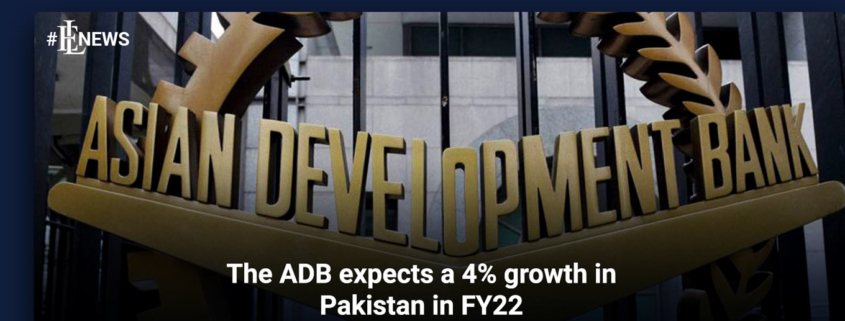The ADB expects a 4% growth in Pakistan in FY22
The ADB expects a 4% growth in Pakistan in FY22. Pakistan’s Gross Domestic Product (GDP) growth is expected to reach 4% in the fiscal year 2021-22 (FY22), as commercial activity gradually restarted in the second year of the Covid-19 epidemic.
According to the Asian Development Outlook 2021, private investment recovered as consumer confidence and business activity increased in response to the ongoing vaccine rollout and several economic stimulus measures outlined in the 2021-22 budget.
According to the research, the investment will likely rise as global sentiment improves and the International Monetary Fund’s stabilization program advances.
On the supply side, agriculture’s prospects are favorable, particularly in light of the government’s ambitious Agriculture Transformation Plan. The ADB expects a 4% growth in Pakistan in FY22.
“The plan aims to ensure food security for a growing population by increasing cultivable land, revamping extension services, increasing water efficiency, developing postharvest storage and food processing facilities, expanding bank credit, and introducing the ‘Kissan Card’ as a digital wallet for the direct and swift transfer of subsidies for seed, pesticides, and fertilizer.”
Similarly, the research predicted that the continued deployment of the Covid-19 immunization program and an accommodative monetary policy would stabilize global merchandise trade, improve market sentiment, and increase corporate and consumer confidence. The ADB expects a 4% growth in Pakistan in FY22.
Additionally, it stated that increased growth in agriculture and industry and anticipated improvement in domestic demand are predicted to boost growth in the services sector, contributing to overall growth improvement in FY22.
“While inflationary pressures will almost certainly arise as a result of the continued economic recovery and rising global oil prices, they should be mitigated by fiscal reform and the government’s pledge to refrain from borrowing directly from the central bank.”
Read more with EL news : Distribution companies demand an Rs2.07 increase in the electricity cost
The ADB projects Pakistan’s economic growth. — Photograph courtesy of the ADB website.
According to the ADB research, the danger of inflation exceeding anticipated levels stems from an unprecedented increase in oil prices or potential currency depreciation resulting from any early termination of the ongoing IMF program.
The budget deficit is about to decrease to 6.9 percent of GDP in FY22, which is still larger than the objective established earlier under an IMF-supported medium-term fiscal contraction program.
“Revenue growth is expected to accelerate as domestic economic activity accelerates and imports increase,” the research stated.
Expenditure is also expected to increase in FY22. The government has budgeted significant increases in subsidies and social and development spending to protect the weak and bolster economic growth and recovery. The ADB expects a 4% growth in Pakistan in FY22.
Pakistan’s state debt is expected to be manageable in the medium future. “As a result of primary and fiscal deficits, excessive borrowing costs, and currency depreciation,” the research stated, “public external debt will reach $95.2 billion in the fiscal year 2021.”
The government has been pursuing a medium-term debt strategy for fiscal years 2020-2023.
“By reclassifying public debt into longer-term instruments, the maturity structure of public debt has been enhanced. With high economic growth forecasts for FY22 and beyond, public debt is expected to continue declining in the medium future, “It was stated.
Domestic demand growth and rising international oil prices are expected to increase the current account deficit to the equivalent of 1.5 percent of GDP in the fiscal year 2022.
Similarly, export growth is predicted to accelerate, aided by a forecast recovery in the economies of Pakistan’s key trading partners.
Exports will gain further from ongoing efforts to cut the cost of doing business, particularly from the government’s recently implemented export facilitation scheme, which allows duty- and tax-free purchasing of inputs such as intermediate products, equipment, and machinery.
Imports are predicted to increase in 2022 due to domestic economic recovery, increased international oil prices, and the fiscal year 2022-23 budget’s rationalization of customs and regulatory taxes.
Additionally, the study stated that remittances were projected to stay high, aided by the ‘Roshan Digital Accounts’ initiative, and would continue to help close the current account deficit. The ADB expects a 4% growth in Pakistan in FY22.
Keep up with Estate Land Marketing for news and updates.




Leave a Reply
Want to join the discussion?Feel free to contribute!